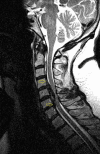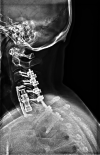Compressive Cervical Myelopathy in Patients With Demyelinating Disease of the Central Nervous System: Improvement After Surgery Despite a Late Diagnosis
- PMID: 33728163
- PMCID: PMC7935266
- DOI: 10.7759/cureus.13161
Compressive Cervical Myelopathy in Patients With Demyelinating Disease of the Central Nervous System: Improvement After Surgery Despite a Late Diagnosis
Abstract
Objective We aimed to assess the impact of surgical intervention on outcome in patients diagnosed with demyelinating disorders and cervical degenerative disease warranting surgical intervention. Methods The records of patients with a diagnosis of a demyelinating disorder of the central nervous system who underwent cervical spine surgery at a single institution from 2016 to 2020 were reviewed. Demyelinating disease included multiple sclerosis (MS), neuromyelitis optica, and transverse myelitis (TM). The dates of initial spine symptom onset, recognition of spinal pathology by the primary provider, referral to spine surgery, and spine surgery procedures were collected. Hospital length of stay (LOS) and postoperative outcomes and complications were recorded. Results A total of 19 patients with a diagnosis of demyelinating disorders underwent cervical spine surgery at our institution. Seventeen patients had MS. The average time interval between a documented diagnosis of myelopathy or radiculopathy and referral to the Spine clinic was 67.95 months (M=40, SD=64.87). Twelve patients had imaging studies depicting degenerative spine disease that would warrant surgical intervention at the time of examination by their primary physician. The average delay for referral to the Spine clinic for these patients was 16.5 months (M=5; SD=25.36). More than 89% of patients experienced significant neurologic improvement postoperatively. Conclusions There is a delay in the recognition of cervical spine disease amenable to a surgical resolution in patients with demyelinating disorders. Surgical treatment can lead to significant clinical improvement in this patient population even if delayed, and likely carries similar risk to that of the general population.
Keywords: anterior cervical discectomy; cervical spine fusion; cervical spondylosis; demyelinating disorders; multiple sclerosis; transverse myelitis.
Copyright © 2021, Youssef et al.
Conflict of interest statement
The authors have declared that no competing interests exist.
Figures




References
-
- Overview of the epidemiology, diagnosis, and disease progression associated with multiple sclerosis. Tullman MJ. https://pubmed.ncbi.nlm.nih.gov/23544716/ Am J Manag Care. 2013;19:15–20. - PubMed
-
- Symptomatic therapy and neurorehabilitation in multiple sclerosis. Kesselring J, Beer S. Lancet Neurol. 2005;4:643–652. - PubMed
-
- Surgical outcome in patients with coexisting multiple sclerosis and spondylosis. Young WF, Weaver M, Mishra B. Acta Neurol Scand. 1999;100:84–87. - PubMed
-
- Surgery for cervical spinal cord compression in patients with multiple sclerosis. Bashir K, Cai CY, Moore TA, Whitaker JN, Hadley MN. Neurosurgery. 2000;47:637–642. - PubMed
-
- Surgical treatment of patients with cervical myeloradiculopathy and coexistent multiple sclerosis: report of 15 patients with long-term follow-up. Arnold PM, Warren RK, Anderson KK, Vaccaro AR. J Spinal Disord Tech. 2011;24:177–182. - PubMed
LinkOut - more resources
Full Text Sources
Other Literature Sources
